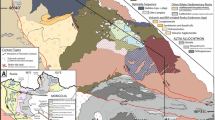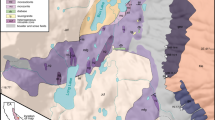Abstract
The simplified model of basalt genesis described in Part I of this series, equilibrium partial melting followed by Rayleigh-type fractional crystallization, is applied to a stratigraphically controlled sequence of basalt flows from Kohala volcano. Major-element compositions were determined for 52 samples and show a time-stratigraphic progression from tholeiites through transitional basalts to alkali basalts. Twenty-six of these samples were analyzed by isotope dilution for K, Rb, Cs, Sr, Ba and the REE, 13 for87Sr/86Sr, and 19 for Co, Cr, Ni and V by atomic absorption.
After a simple, first-order correction for the effects of fractional crystallization (involving mostly olivine and aluminous clinopyroxene), the major element concentrations cluster tightly, and the incompatible trace elements show monotonic increases in concentration as a function of stratigraphic height. The process identification plot shows that all the (fractionation corrected) melt compositions can be explained by equilibrium partial melting of compositionally identical batches of source material. The REE and Sr are fractionated because of the presence of residual clinopyroxene. Garnet may also be present but in much smaller amounts. In this respect our results differ significantly from those of Leeman et al. (1980).
The calculated chondrite-normalized REE patterns of the source are nearly flat to slightly convex upward. Therefore there is no need to invoke special mechanisms, such as metasomatic REE preenrichment of the source, in order to explain the petrogenesis of the suite of lavas. Specifically, Ce concentrations ranging from 20 to 250 times chondritic are all explained by the same calculated source pattern having a chondrite-normalized ratio of Ce/Sm=0.9±0.2. However, the normalized ratio Ce/Ba≅2 shows that the source is not simply primitive mantle.
Similar content being viewed by others
References
Beeson MH, Jackson ED (1970) Origin of the garnet pyroxenite xenoliths at Salt Lake Crater, Oahu. Mineral Soc Am Spec Paper 3:95–112
Beeson MH (1976) Petrology, mineralogy and geochemistry of the East Molokai Volcanic series, Hawaii. USGS Prof Paper 961:53 p
Bence AE, Albee AL (1968) Empirical correction factors for the electron microanalysis of silicates and oxides. J Geol 76:382–403
Chen C-Y, Frey FA (1983) Origin of Hawaiian tholeiite and alkalic basalt. Nature 302:785–789
Clague DA, Beeson MH (1980) Trace element geochemistry of the East Molokai volcanic series, Hawaii. Am Jour Sci 280-A:820–844
Clague DA, Frey FA (1982) Petrology and trace element geochemistry of the Honolulu volcanics, Oahu: Implications for the oceanic mantle beneath Hawaii. J Petrol 23:447–504
Feigenson MD (1983) A general model for the origin of alkali basalts from Hawaii, in review, Contrib Mineral Petrol
Flanagan FJ (1973) 1972 values for international geochemical reference samples. Geochim Cosmochim Acta 37:1189–1200
Flanagan FJ (1974) Descriptions and analyses of seven new USGS rock standards. USGS Prof Paper 840
Frey FA (1980) The origin of pyroxenites and garnet pyroxenites from Salt Lake Crater, Oahu, Hawaii: trace element evidence. Am J Sci 280-A:427–449
Hanson GN (1980) Rare earth elements in petrogenetic studies of igneous systems. Ann Rev Earth Planet Sci 8:371–406
Hart SR, Brooks C (1974) Clinopyroxene-matrix partitioning of K, Rb, Cs, Sr and Ba. Geochim Cosmochim Acta 38:1799–1806
Hart SR, Davis KE (1978) Nickel partitioning between olivine and silicate melt. Earth Planet Sci Lett 40:203–219
Irving AJ (1978) A review of experimental studies of crystal/liquid trace element partitioning. Geochim Cosmochim Acta 42:743–770
Irving AJ (1980) Petrology and geochemistry of composite ultramafic xenoliths in alkalic basalts and implications for magmatic processes within the mantle. Am J Sci 280-A: 389–426
Kay RW, Hubbard NJ (1978) Trace elements in ocean ridge basalts. Earth Planet Sci Lett 38:95–116
Leeman WP, Murali AV, Ma M-S, Schmitt RA (1977) Mineral constitution of mantle source regions for Hawaiian basalts — rare earth element evidence for mantle heterogeneity. Proc of the Chapman Conf on Partial Melting in the Upper Mantle Sept 10–14, 1976 Brookings OR
Leeman WP, Budahn JR, Gerlach DC, Smith DR, Powell BN (1980) Origin of Hawaiian tholeiites: trace element constraints. Am J Sci 280-A:794–819
MacDonald GA, Katsura T (1964) Chemical composition of Hawaiian lavas. J Petrol 5:82–133
Minster JF, Allègre CJ (1978) Systematic use of trace elements in igneous processes, part III. Inverse problem of batch melting in volcanic suites. Contrib Mineral Petrol 68:37–52
Nakamura N (1974) Determination of REE, Ba, Fe, Mg, Na and K in carbonaceous and ordinary chondrites. Geochim Cosmochim Acta 38:757–775
Nicholls IA, Harris KC (1980) Experimental rare earth element partition coefficients for garnet, clinopyroxene and amphibole coexisting with andesitic and basaltic liquids. Geochim Cosmochim Acta 44:287–308
O'Hara MJ (1977) Geochemical evolution during fractional crystallization of a periodically refilled magma chamber. Nature 266:503–507
O'Hara MJ, Mathews RE (1981) Geochemical Evolution in an advancing, periodically replenished, periodically tapped, continuously fractionated magma chamber. J Geol Soc Lond 138:237–277
O'Nions RK, Hamilton PJ, Evenson NM (1977) Variations in143Nd/144Nd and87Sr/86Sr ratios in oceanic basalts. Earth Planet Sci Lett 34:13–22
Shimizu N, Kushiro I (1975) The partitioning of rare earth elements between garnet and liquid at high pressures: preliminary experiments. Geophys Res Lett 2:413–416
Sun S-S, Nesbitt RW, Sharaskin AYa (1979) Geochemical characteristics of mid-ocean ridge basalts. Earth Planet Sci Lett 44:119–138
Stearns HT, MacDonald GA (1946) Geology and ground-water resources of the island of Hawaii. Hawaii Div Hydrogr Bull 9:363 p
Tera F, Eugster O, Burnett DS, Wasserburg GJ (1970) Comparative study of Li, Na, K, Rb, Cs, Ca, Sr and Ba abundances in achondrites and in Apollo 11 lunar samples. Proc Apollo 11 Lunar Sci Conf 2, 1637–1657
White WM, Hofmann AW (1982) Sr and Nd isotope geochemistry of oceanic basalts and mantle evolution. Nature 296:821–825
Wright TL, Doherty PC (1970) A linear programming and least squares computer method for solving petrological mixing problems. Bull Geol Soc Am 81:1995–2008
Wright TL, Swanson DA, Duffield WA (1975) Chemical Compositions of Kilauea East-Rift lava, 1968–1971. J Petrol 16:110–133
Yoder HS Generation of Basaltic Magma. National Academy of Sciences 1976:265 p
Author information
Authors and Affiliations
Rights and permissions
About this article
Cite this article
Feigenson, M.D., Hofmann, A.W. & Spera, F.J. Case studies on the origin of basalt. Contr. Mineral. and Petrol. 84, 390–405 (1983). https://doi.org/10.1007/BF01160290
Received:
Accepted:
Issue Date:
DOI: https://doi.org/10.1007/BF01160290




